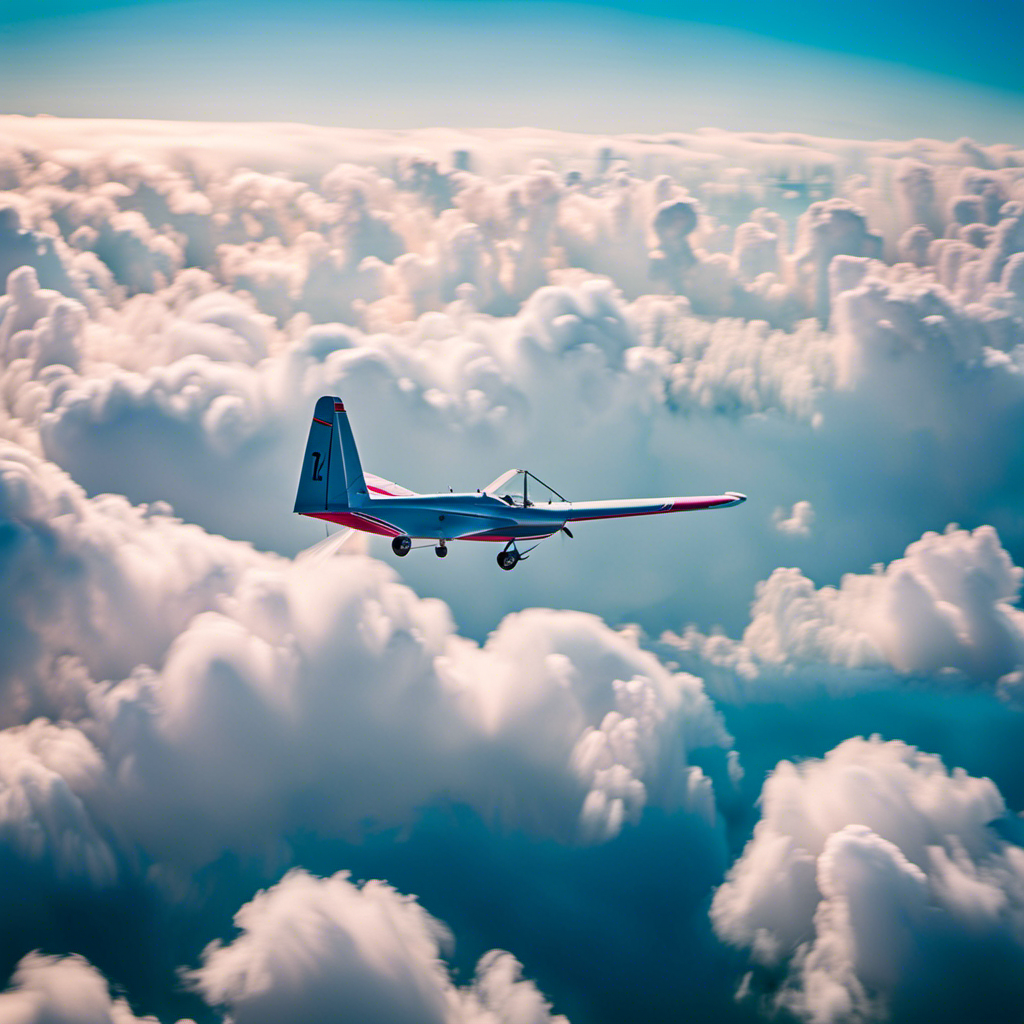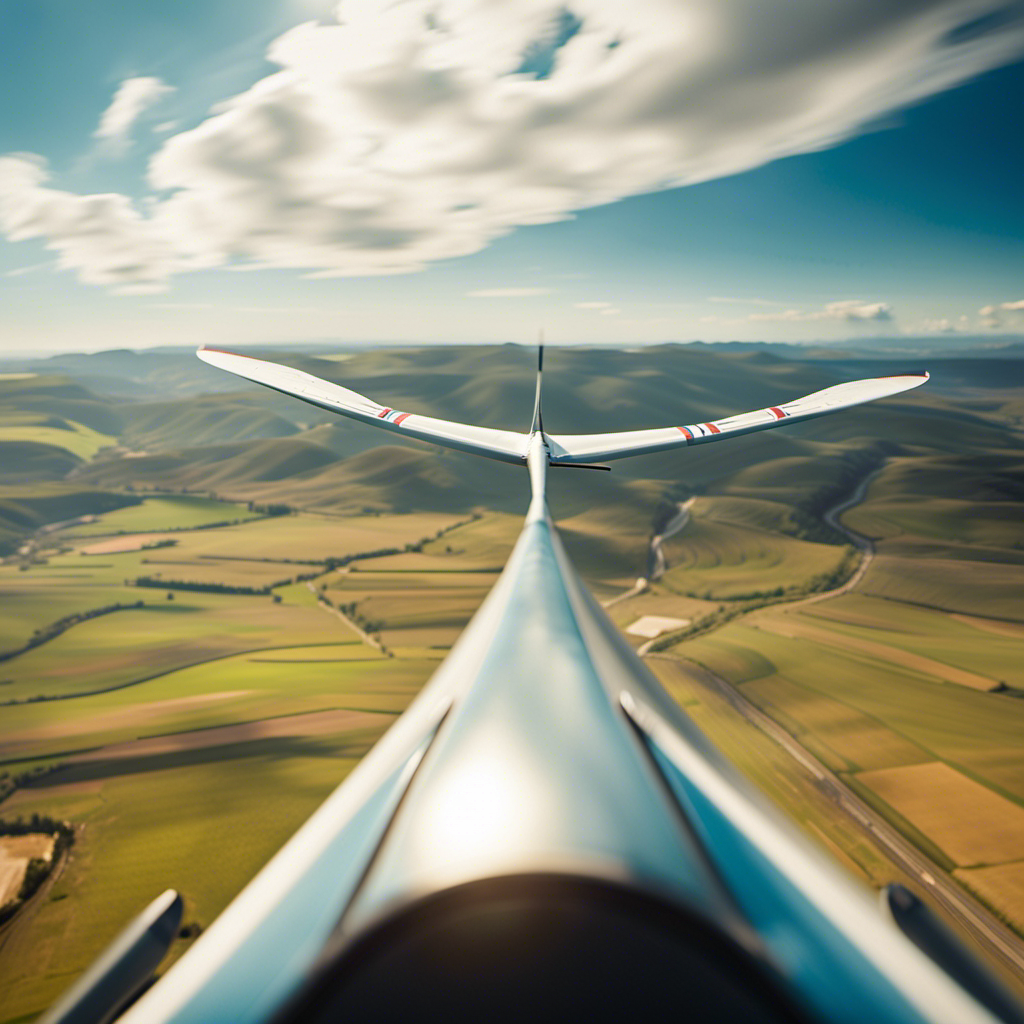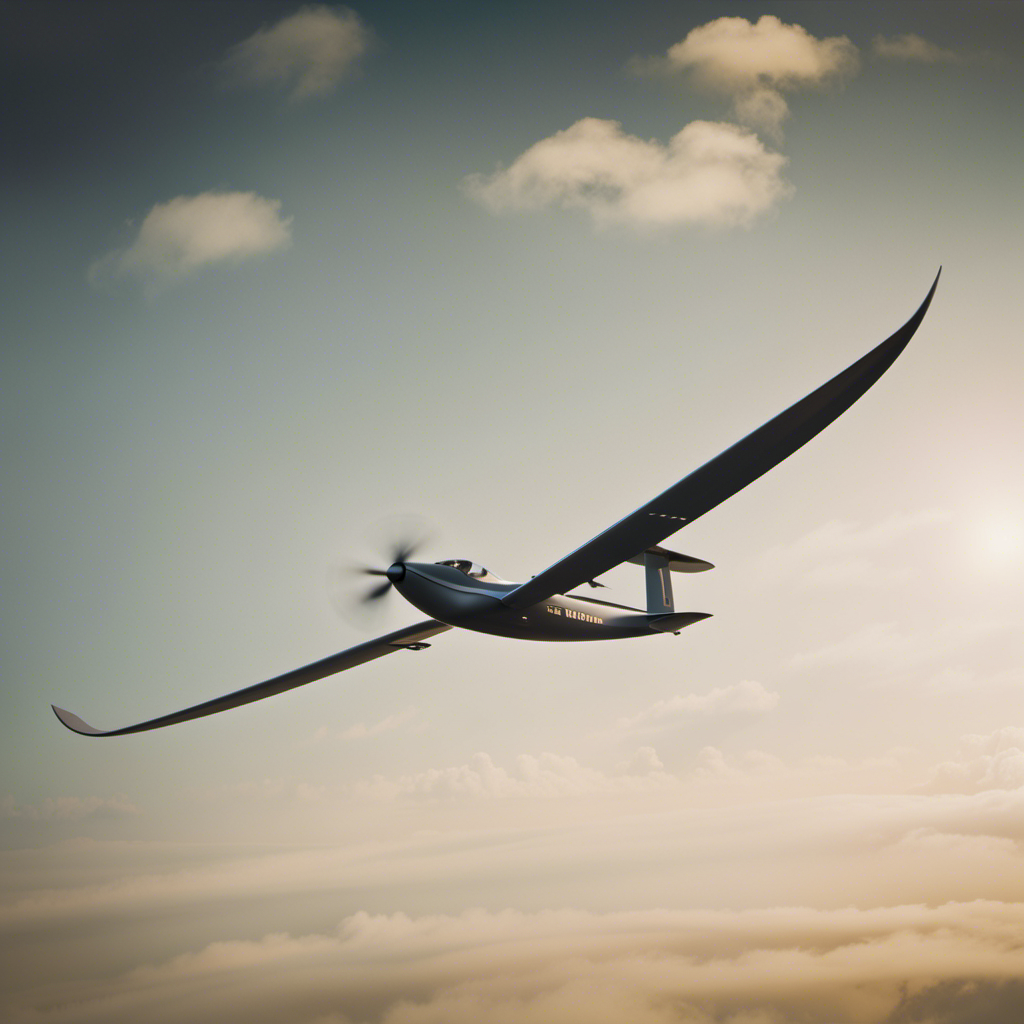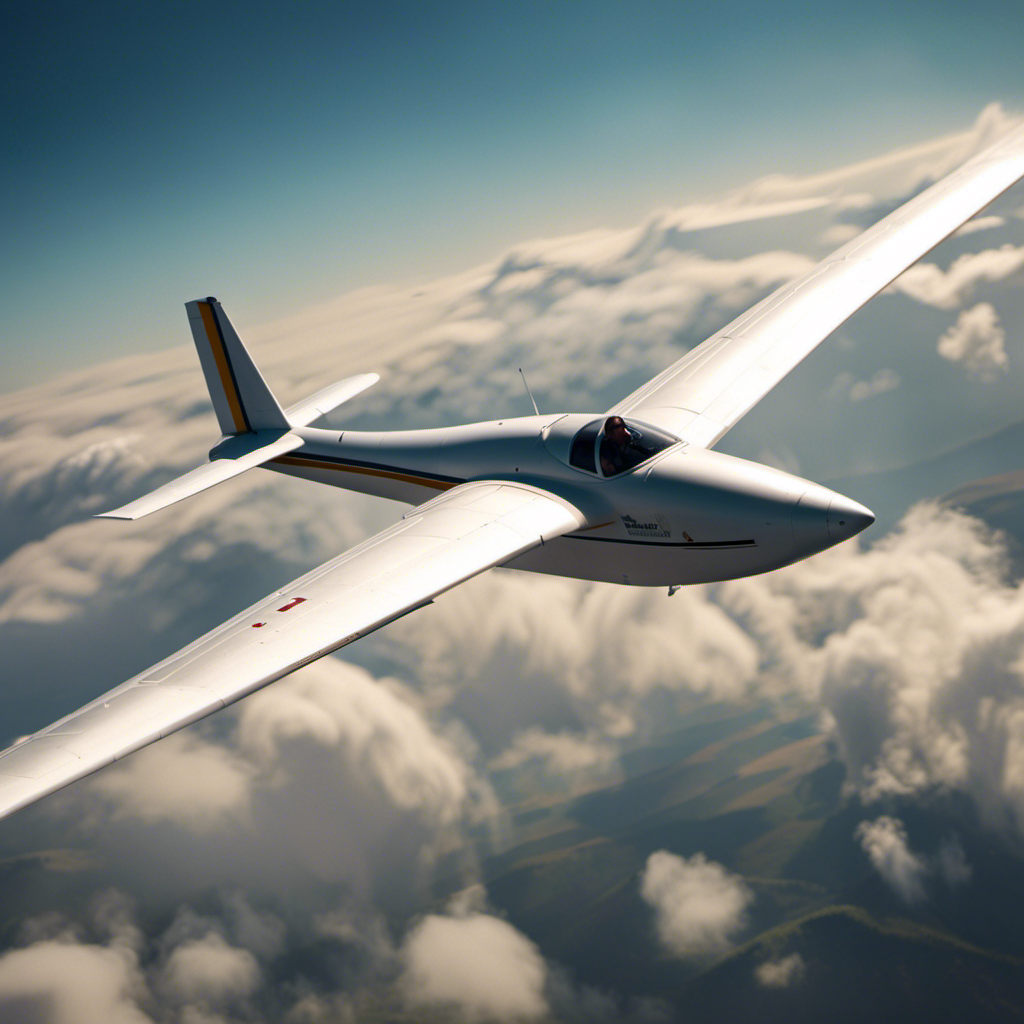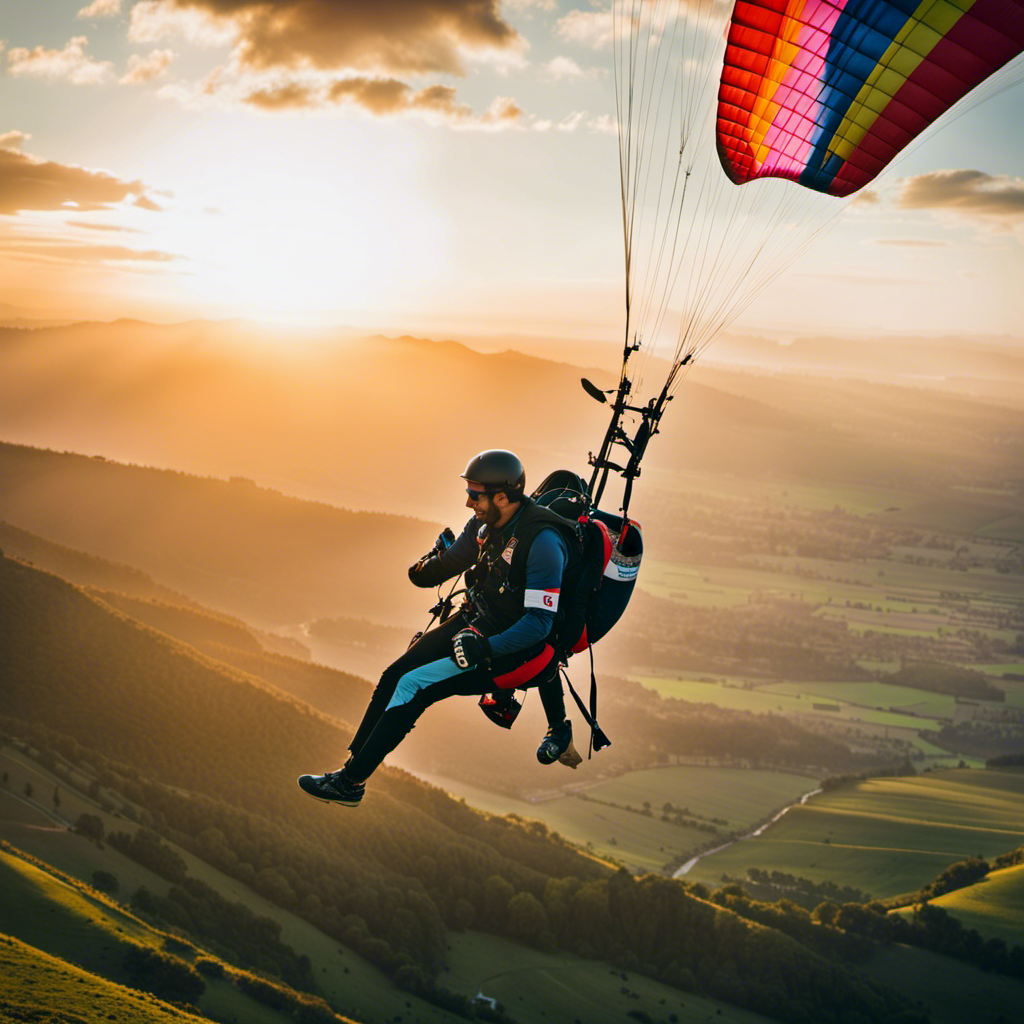It is commonly stated that time appears to pass quickly when you are having fun, and based on my experience as a glider pilot, I can affirm that this statement is accurate.
Each day brings a thrilling adventure as I take to the skies in my sleek glider, powered only by the wind and my skillful maneuvers.
From the moment I prepare for flight to the exhilarating moments in the air, being a glider pilot is a captivating journey that requires dedication, precision, and a deep love for the art of soaring.
Key Takeaways
- Glider pilots must conduct a thorough pre-flight inspection and analyze current weather conditions to ensure a safe and successful flight.
- Mastering gliding techniques such as utilizing thermals and ridge lift is crucial for extending flight time and gaining altitude.
- Post-flight reflection and analysis are essential for identifying areas of improvement and fine-tuning skills for proficiency.
- Engaging with the gliding community, participating in competitions, and networking with other pilots are important for celebrating achievements, sharing experiences, and advancing the gliding community.
Preparing for Flight
Before taking off, you’ll need to complete a thorough pre-flight inspection of your glider. This involves going through a pre-flight checklist to ensure that all the necessary components are in working order.
I start by checking the control surfaces, making sure they move freely and without any resistance. Then, I inspect the wings, looking for any signs of damage or wear. Next, I examine the landing gear, ensuring that it is secure and functioning properly. Additionally, I inspect the cockpit instruments, ensuring that they are calibrated and accurate.
Once the physical inspection is complete, I move on to the weather analysis. I check the current weather conditions, paying attention to factors such as wind speed, direction, and temperature. This information helps me determine if it is safe to fly and what kind of flight conditions I can expect.
Taking Off
Once you’re strapped in and ready, you’ll feel the rush of adrenaline as you accelerate down the runway, preparing to take off. As a glider pilot, safety is of utmost importance, and following a pre-flight checklist is crucial to ensure a smooth and secure flight.
Here are the key safety procedures I go through before taking off:
- Perform a thorough inspection of the glider, checking the control surfaces, cables, and connections for any signs of damage or wear.
- Verify that the instruments are functioning properly, including the altimeter, variometer, and airspeed indicator.
- Confirm that the parachute is securely fastened and accessible in case of an emergency.
Completing these steps gives me peace of mind knowing that I’ve taken all necessary precautions to ensure a safe flight. As the glider gains speed and lifts off the ground, the exhilaration sets in.
As the glider soars higher into the sky, the world below transforms into a breathtaking view. The transition from the ground to the air is a moment of liberation and freedom, where the constraints of gravity are temporarily overcome.
In the Air
As I’m soaring through the sky, I can’t help but marvel at the breathtaking view below. Being a glider pilot allows me to experience the freedom of flight without an engine. It’s a unique sensation, relying on the natural forces of the atmosphere to stay aloft.
One of the key techniques I use to stay airborne is riding thermals. These are columns of warm air that rise from the ground due to heating by the sun. By circling within a thermal, I can gain altitude and stay airborne for longer periods.
Another technique I employ is using ridge lift. This occurs when the wind encounters a ridge or mountain slope, causing it to rise. By flying close to the ridge, I can take advantage of this upward wind and maintain altitude. It’s an efficient way to cover long distances without the need for a motor.
Transitioning into the subsequent section about gliding techniques, mastering these skills allows me to maximize my time in the air and explore the possibilities of gliding. By understanding the intricacies of thermals and ridge lift, I can make informed decisions to extend my flight and reach new destinations.
Gliding Techniques
When it comes to gliding techniques, there are a few key points to consider.
Firstly, riding thermals is a technique where glider pilots take advantage of rising columns of warm air to gain altitude.
Secondly, using ridge lift involves flying close to mountain ridges or cliffs to catch the updrafts created by the wind hitting the terrain.
Lastly, performing aerobatics is a skill that requires precision and control. This allows pilots to execute maneuvers such as loops, rolls, and spins in the glider.
Riding Thermals
Feel the rush of soaring through the sky as you catch thermals to stay aloft in your glider. Exploring thermals is an essential skill for any glider pilot, as it allows us to maximize lift and extend our flight time.
Thermals are pockets of warm air that rise from the earth’s surface due to heating from the sun. When flying, we search for these thermals by observing the behavior of birds, cloud formations, and the landscape below. Once we find a thermal, we maneuver our glider to enter it and ride the rising air currents. By circling within the thermal, we can gain altitude and continue our flight.
Now, let’s transition to the next technique we use to stay airborne: using ridge lift.
Using Ridge Lift
To maximize your flight time and stay aloft, you’ll want to learn how to use ridge lift effectively. Ridge soaring is a technique used in glider flying where pilots harness the upward wind created by the slope of a ridge.
Here are three key tips for utilizing ridge lift:
-
Positioning: To take advantage of ridge lift, pilots must position their glider parallel to the ridge, flying in a straight line along its contour. This allows the air flowing up the slope to lift the glider.
-
Indications: Observing visual indicators such as birds soaring along the ridge or experiencing a sudden increase in altitude can help pilots identify areas of strong ridge lift.
-
Safety: It’s important to understand that ridge lift can be turbulent, so maintaining proper control of the glider and avoiding excessive banking is crucial for safe ridge flying.
By mastering ridge soaring techniques, pilots can extend their flight duration and explore new areas.
Transitioning into performing aerobatics requires a different set of skills and mindset.
Performing Aerobatics
After enjoying the exhilaration of soaring on ridge lift, it’s time to take my glider to new heights and explore the world of aerobatics. Performing aerobatics requires precision, skill, and a thorough understanding of the aircraft’s capabilities.
Safety is paramount in aerobatics, and pilots must adhere to strict guidelines to minimize risks. Before attempting any maneuvers, a thorough pre-flight inspection is conducted to ensure the glider is in optimal condition.
Aerobatics competitions provide a platform for pilots to showcase their skills and compete against others in various categories such as precision, freestyle, and team aerobatics. These competitions not only test the pilot’s abilities but also foster camaraderie and a sense of community among aerobatic enthusiasts.
Mastering the challenges of aerobatics requires dedication, practice, and a deep understanding of the aircraft’s limitations, which I will delve into in the next section.
Challenges and Skills
You’ll need to have sharp focus and quick decision-making skills to overcome the challenges of glider piloting. Glider flying presents its fair share of obstacles that require a pilot to be adaptable and skilled.
One of the biggest challenges is the lack of an engine, which means you have to constantly search for thermals and other sources of lift to stay airborne. This requires a deep understanding of aerodynamics and the ability to read the sky.
Another obstacle is the weather, which can change rapidly and affect the availability of lift. As a glider pilot, you must be able to interpret weather patterns and make quick decisions about when to fly and when to stay on the ground.
Mastering techniques such as thermalling and ridge soaring is crucial in order to maximize your time in the air. These techniques involve flying in tight circles or along ridges to take advantage of upward air currents.
With practice and experience, you can become adept at overcoming these obstacles and mastering the skills needed for successful glider piloting.
Now, let’s transition to the next section about landing.
Landing
When landing a glider, it’s important to approach the runway at the correct angle and maintain a steady descent rate. Landing a glider can present several challenges, including dealing with crosswinds, judging the correct height and distance from the runway, and executing a smooth touchdown. To overcome these challenges, glider pilots employ various landing techniques.
One common landing technique is the crab landing, which involves aligning the glider with the runway while maintaining a slight crab angle to counteract crosswinds. This technique requires careful coordination of the rudder and ailerons to maintain control and ensure a safe touchdown.
Another landing technique is the slip landing, which is used to increase the descent rate without gaining excessive airspeed. By applying opposite rudder and aileron inputs, the glider is maneuvered into a sideslip, which increases drag and steepens the descent angle.
Post-flight reflection is an essential part of a glider pilot’s routine. It allows me to review my performance during the flight and identify areas for improvement. By analyzing my landing techniques, I can fine-tune my skills and become a more proficient glider pilot.
Post-Flight Reflection
After completing a flight, it’s essential for me as a glider pilot to review my flight performance. This involves analyzing my decision-making, maneuvering skills, and adherence to safety protocols.
It’s equally important to celebrate successful flights and acknowledge the achievements and milestones reached during each flight. However, it’s also crucial to analyze areas for improvement in order to continually enhance my skills and minimize any potential risks or mistakes in future flights.
Reviewing Flight Performance
To improve your flight performance, try reviewing your glider’s performance data after each flight. This allows you to gain valuable insights into your flying techniques and identify areas for improvement. When reviewing flight data, consider the following:
-
Evaluate flight maneuvers: Analyze the data to assess the effectiveness of different maneuvers performed during the flight. Look for patterns or trends that can help you refine your technique.
-
Monitor airspeed and altitude: Examine the recorded data to ensure that you maintained appropriate airspeed and altitude throughout the flight. This information can help you optimize your glider’s performance in future flights.
-
Assess energy management: Review the energy management data to understand how efficiently you utilized the glider’s potential energy. This can help you make adjustments to maximize your glider’s performance.
By carefully reviewing your flight data, you can make informed decisions to enhance your flying skills and ensure a safer and more enjoyable flight experience.
Now, let’s move on to the next section and celebrate the success of our flights.
Celebrating Successful Flights
Now, let’s take a moment to celebrate our successful flights and reflect on the amazing experiences we’ve had.
As glider pilots, we have developed celebratory traditions to recognize our team accomplishments. After a particularly successful flight, we gather around a bonfire and share stories of our adventures in the sky. We toast to our achievements and express our gratitude for the smooth flights and perfect landings. This moment of celebration not only brings us closer as a team but also allows us to appreciate the unique thrill of soaring through the air.
However, as we revel in our accomplishments, it’s important to also analyze areas for improvement. By reflecting on our flights, we can identify ways to enhance our skills and ensure even greater success in the future.
Analyzing Areas for Improvement
As we celebrate our successful flights, let’s also take a moment to analyze areas where we can improve. When it comes to glider flying, improving safety and optimizing efficiency are key goals.
Here are some aspects that deserve our attention:
-
Enhancing pre-flight checks: By conducting thorough inspections, we can identify potential issues and prevent accidents before takeoff.
-
Implementing advanced training programs: Continuous learning and skill development can equip pilots with the necessary techniques to handle challenging situations effectively.
-
Integrating advanced technology: Utilizing modern instruments and systems can enhance navigation, communication, and overall flight management.
-
Collaborating with air traffic controllers: Establishing better coordination with ATC can help improve communication and ensure safer flight operations.
Engaging with the Gliding Community
When it comes to engaging with the gliding community, there are several key points to consider.
Firstly, connecting with other pilots is essential for networking, learning, and sharing experiences.
Secondly, participating in competitions not only allows you to test your skills and knowledge but also provides an opportunity to meet fellow glider enthusiasts.
Lastly, sharing experiences and tips with others is a great way to contribute to the community and help fellow pilots improve their flying skills.
Connecting with Other Pilots
Don’t forget to reach out and connect with other pilots at the glider club today.
As a glider pilot, one of the most rewarding aspects of this sport is the opportunity to make lifelong friendships with fellow enthusiasts. By getting involved in gliding events and taking the time to connect with other pilots, you can expand your knowledge, learn from their experiences, and build a strong network within the gliding community.
This camaraderie not only enhances your flying experience but also opens doors to new opportunities and adventures. Whether it’s discussing techniques, sharing stories, or simply enjoying a meal together, the connections you make with other pilots can greatly enrich your journey as a glider pilot.
Speaking of connections, let’s explore the next exciting aspect of being a glider pilot: participating in competitions.
Participating in Competitions
To fully immerse yourself in the gliding community, it’s time to start participating in competitions and showcase your skills.
Competing in gliding competitions not only allows you to showcase your abilities but also provides an opportunity to learn from experienced pilots and gain valuable insights into competing strategies.
When it comes to competing in gliding, there are various strategies that pilots employ. Some focus on maximizing speed, while others prioritize efficiency and finding the best lift.
The scoring criteria in gliding competitions typically include factors such as distance covered, time aloft, and accuracy of landing. By understanding the competing strategies and scoring criteria, you can better prepare yourself for the challenges ahead.
As you gain experience in competitions and improve your skills, you’ll have valuable experiences and tips to share with others in the gliding community.
Sharing Experiences and Tips
After a thrilling experience of participating in glider competitions, the next step is to connect with fellow glider pilots and share our experiences and tips. Exchanging stories and seeking advice from seasoned pilots is an essential part of our journey to become better aviators. Here are four ways we engage in this practice:
-
Fly-ins: We gather at designated locations to share our flying adventures, discuss techniques, and learn from each other.
-
Online forums: Virtual communities provide a platform to connect with pilots worldwide, ask questions, and share knowledge.
-
Glider clubs: These clubs organize regular meetings where pilots can bond, exchange stories, and receive guidance from experienced members.
-
Mentoring programs: Joining a mentorship program allows aspiring pilots to learn from experienced mentors who provide guidance and support.
As we continue to grow in our passion for glider flying, the next section will focus on the importance of training and certification in this field.
Training and Certification
When it comes to learning the basics of gliding, it is crucial to understand the fundamental principles of flight, such as controlling the aircraft’s pitch, roll, and yaw.
As I progressed in my training, I began to delve into more advanced techniques, such as thermalling and cross-country flying, which allowed me to explore new horizons and challenge myself further.
Obtaining pilot certifications, like the Private Pilot License (PPL) or the Glider Instructor Rating (GI), not only showcases one’s proficiency in the sport but also opens up opportunities for instructing others and sharing the joy of gliding.
Learning the Basics of Gliding
While learning the basics of gliding, I must become proficient in controlling the aircraft’s pitch, roll, and yaw. It is crucial to understand how these three components interact with each other to maintain stability and control in the air.
During my training, mistakes are inevitable, but they serve as valuable learning opportunities. By analyzing and understanding these mistakes, I can improve my skills and build confidence in my abilities as a glider pilot.
As I gain more experience and proficiency in the basics, I can then advance to advanced techniques such as thermalling, ridge soaring, and cross-country flying. These techniques will further enhance my flying skills and open up new possibilities for exploration and adventure in the world of gliding.
Advancing to Advanced Techniques
After mastering the basics of gliding, it’s time to take my skills to the next level. I need to advance to advanced soaring techniques and refine my flying skills. This phase of my training is crucial in becoming a proficient glider pilot.
Here are some of the advanced techniques I have been working on:
- Thermaling: Learning how to find and exploit thermals efficiently to gain altitude and extend my flight time.
- Ridge Soaring: Utilizing the windward side of a ridge to generate lift and maintain altitude, allowing for longer flights.
- Cross-Country Flying: Planning and executing flights over long distances, navigating through different thermals and ridge lift to reach specific destinations.
By honing these advanced soaring techniques and continuously refining my flying skills, I am preparing myself for the challenges that lie ahead. I am working towards obtaining pilot certifications.
Transitioning into the next section, let’s now explore the process of obtaining these certifications.
Obtaining Pilot Certifications
To obtain pilot certifications, it’s essential to complete the necessary training and meet the requirements set by the aviation authorities.
Training programs offered by flight schools are designed to provide aspiring pilots with the knowledge and skills required for safe and efficient flying. These programs cover a wide range of subjects, including aerodynamics, meteorology, navigation, and emergency procedures.
Flight schools also offer practical training, where students gain hands-on experience in operating aircraft under the guidance of experienced instructors.
Through rigorous training and examinations, aspiring pilots can earn various certifications, such as private pilot, commercial pilot, and instrument rating. These certifications not only validate a pilot’s skills and knowledge but also open up opportunities for career advancement and specialization.
With the necessary certifications in hand, pilots can now explore the joys of gliding and experience the freedom of soaring through the skies.
The Joys of Gliding
One of the joys of gliding is feeling the rush of wind as you soar through the air. As a glider pilot, I have experienced the thrill of soaring and exploring new horizons firsthand. Gliding allows me to embrace the freedom of flight without the noise and vibration of an engine. It’s a pure and serene form of aviation that brings a unique sense of tranquility.
When I take to the skies in a glider, I am able to appreciate the beauty of the world from a different perspective. The feeling of being suspended in the air, effortlessly riding the currents, is truly exhilarating. It’s like floating on a gentle breeze, as if I am a part of the sky itself.
To give you a glimpse into the joys of gliding, let me share a table that highlights some of the key aspects of this incredible sport:
| Thrill of Soaring | Exploring New Horizons |
|---|---|
| Sense of freedom | Expanding horizons |
| Adrenaline rush | Discovering new landscapes |
| Serene and peaceful | Pushing personal limits |
Gliding allows me to push myself beyond my comfort zone and explore new territories. It’s not just about the destination, but the journey itself. The ability to navigate through the air, using thermals and updrafts to stay aloft, is a skill that requires precision and finesse.
Frequently Asked Questions
How long does it take to become a certified glider pilot?
Becoming a certified glider pilot requires a significant time commitment and training. The process typically involves several months of instruction, including ground school and flight training, as well as passing written and practical exams.
What are some common challenges that glider pilots face during flight?
Challenges faced by glider pilots include unpredictable weather conditions, limited visibility, and maintaining control in turbulent air. Safety measures such as pre-flight checks and constant monitoring of instruments help mitigate these challenges.
Are there any specific techniques or strategies that glider pilots use to navigate through different weather conditions?
Glider pilots use various techniques and strategies to navigate through different weather conditions. They rely on weather forecasts, visual cues, and instruments to make informed decisions, such as choosing optimal routes and altitudes for avoiding turbulence and maximizing lift.
How do glider pilots ensure their safety during landing?
Ensuring safety during landing is crucial. I employ landing techniques like the "flare," where I smoothly reduce speed and control descent. This ensures a gentle touchdown, minimizing the risk of accidents.
What are some ways that glider pilots connect and engage with the gliding community?
Glider pilots connect and engage with the gliding community through various ways, such as attending glider pilot events and competitions. These events provide opportunities to network, share experiences, and learn from fellow pilots, fostering a sense of camaraderie within the gliding community.
Conclusion
In conclusion, being a glider pilot is a thrilling and rewarding experience. The statistics show that gliding has become increasingly popular in recent years, with over 150,000 certified glider pilots worldwide.
This exciting sport offers a unique perspective of the world from above, as pilots navigate the sky using only the power of the wind. It requires a combination of skill, knowledge, and a deep love for aviation.
So if you’re looking for an adrenaline-filled adventure and a chance to soar like a bird, gliding might just be the perfect sport for you.
With a heart that soars as high as the skies, Aria, affectionately known as “Skylark,” is the driving force behind Soaring Skyways. Her journey into the gliding world began as a young dreamer gazing up at the soaring birds, yearning to experience the weightlessness and freedom they embodied. With years of experience both in the cockpit and behind the scenes, Aria’s commitment to the gliding community is unwavering.
